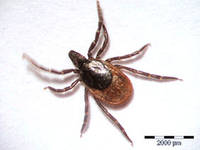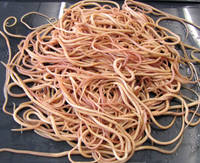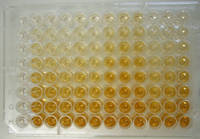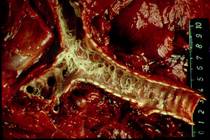
Prof. Dr. med. vet. Christina Strube, PhD
Tel 0511 - 953 8711
Fax 0511 - 953 828793
E-Mail senden

Veterinary Public Health
Ein Forschungsschwerpunkt der Arbeitsgruppe ist Veterinary Public Health. Dieser unterteilt sich in die Forschungsgebiete „Zecken-übertragene Krankheiten“ sowie "parasitäre Zoonosen". Das Forschungsgebiet Zecken-übertragene Krankheiten (TBD, Tick-Borne Diseases) beinhaltet die Verbreitung und Häufigkeit von Zecken sowie die Verbreitung und Übertragung von TBDs, insbesondere heimische durch Zecken übertragene Krankheiten. Hierbei ist der Fokus auf molekulare Nachweismethoden und die Epidemiologie der pathogenen Organismen sowie Risikofaktoranalyse und Modellrechnungen zur Zeckenabundanz und dem Risiko für die öffentliche Gesundheit gerichtet:
- Vorkommen und Häufigkeit verschiedener Zeckenarten in Hannover und anderen Gebieten Deutschlands
- Multifaktorielle Modellierung des Zeckeninfestations-Risikos für die öffentliche Gesundheit
- Epidemiologisches Langzeitmonitoring zur saisonalen und regionalen Häufigkeit von Borrelien-, Anaplasmen- und Rickettsien-infizierten Zecken in Hannover
- Untersuchungen zur jahreszeitlichen Häufigkeit von Borrelien-, Anaplasmen- und Rickettsien-infizierten Zecken in verschiedenen norddeutschen Städten bzw. Landkreisen
- Identifizierung von FSME-Risikogebieten in Norddeutschland
- Quantitative real-time PCR zur Identifizierung von FSME-Viren in Zecken
- Quantitative real-time PCR basierend auf Oligonukleotidsonden (TaqMan-Minor Groove Binder) zur Identifizierung von Borrelien, Anaplasmen und Rickettsien in Zecken
- Speziesdifferenzierung pathogener Mikroorganismen mittels RLB, PCR und DNA-Sequenzierung
- Pyrosequencing-Technologie zur Differenzierung von Rickettsienarten

Parasitäre Zoonosen
Der Forschungsschwerpunkt parasitäre Zoonosen konzentriert sich auf Spulwürmer als vom Tier auf den Menschen übertragbare Krankheitserreger.
Neben Studien zum zoonotischen Potenzial und dem Infektionsrisiko in stätischen, der Öffentlichkeit zugänglichen Bereichen werden Parasit-Wirt-Interaktionen mit molekularen und serologischen Techniken untersucht.
Im Mittelpunkt stehen dabei folgende Projekte:
- Folgen eines Ascaris suum Befalls für den intestinalen Nährstofftransport
- Interaktion von Toxocara spp. mit dem angeborenen Immunsystem
- Neuropathologie der Toxocara Infektion im paratenischen Wirt

Epidemiologie von Parasiteninfektionen bei Nutz-, Haus- und Wildtieren
Als weiterer Forschungsaspekt ist die Epidemiologie von Parasiteninfektionen bei Nutz-, Haus- und Wildtieren zu nennen, wobei Helminthen und Arthropoden im Fokus stehen.
Neben dem Einsatz etablierter Verfahren werden auch naive und rekombinante Antigene für verbesserte diagnostische Nachweismöglichkeiten evaluiert.
Diese finden Einsatz in serologischen Untersuchungen von Blut und Milch.
Eingebundene Projekte sind:
- Epidemiologie von Endoparasiten bei Hund und Katze
- Immundiagnostik von Infektionen und Antikörpertiterverlauf auf Individual- und Herdenebene
- Vorkommen von Lungenwürmern, Leberegeln und gastrointestinalen Nermatoden bei Rindern in Deutschland und dem europäischen Ausland
- Verbreitung von Geflügelparasiten in Norddeutschland
- Untersuchungen zum Parasitenbefall bei verschiedenen terrestrischen Wildtieren
- Epidemiologie von Lungenwürmern bei aquatischen Wieldtieren (Robben und Schweinswale)

Bekämpfung des bovinen Lungenwurms Dictyocaulus viviparus
Ein weiters Forschungsgebiet umfasst die molekularen Mechanismen zur Biologie und Entwicklung sowie zur Bekämpfung des bovinen Lungenwurms Dictyocaulus viviparus.
Ein wesentliches Ziel der Forschungsarbeiten sind dabei die Identifizierung molekularer Vorgänge während der Parasitenentwicklung sowie die Evaluierung rekombinanter Vakzinekanditaten.
Folgende Themen werden behandelt:
- Transkriptom- und Genomsequenzierung
- Genregulation der Hypobiose
- Molekulare Charakterisierung, heterologe prokaryotische und eukaryotische Expresson sowie Funktionsprüfung von Cysteinproteasen
- Subunitvakzinierung gegen Dictyocaulus viviparus.
Beruflicher Werdegang
2013 - Universitätsprofessorin und Direktorin des Instituts für Parasitologie der TiHo Hannover
- Ruf (ad primo loco) auf die W3-Professur „Parasitologie“, Tierärztliche Hochschule Hannover (Ruf angenommen
- Ruf (ad primo loco) auf die W3-Professur „Parasitologie und vergleichende Tropenmedizin“ , Ludwig-Maximilians-Universität München (Ruf abgelehnt)
2010 - 2013 Juniorprofessorin, TiHo Hannover
2010 Promotion zum Dr. med. vet.
2008 - 2010 Zertifikatskurs „Professionelle Lehre“
2008 Fachtierärztin für Parasitologie
2003 - 2010 Wissenschaftliche Mitarbeiterin im Institut für Parasitologie, TiHo
2004 Promotion zum Doctor of Philosophy (PhD)
2000 – 2004 Promotionsstudium im PhD-Programm der TiHo Hannover
2000 Approbation als Tierärztin
1994 – 2000 Studium der Veterinärmedizin an der TiHo Hannover
Stipendien und Auszeichnungen
Stipendien
Mai 2001- September 2003 Stipendiatin der Karl-Enigk-Stiftung
Auszeichnungen
2004 Förderpreis Tiermedizin der Kurt-Alten-Stiftung für eine herausragende PhD-These
2012 Preis der Dres. Jutta & Georg Bruns Stiftung für innovative Veterinärmedizin
2013 Förderpreis der Akademie für Tiergesundheit (AfT)
Publikationen
Artikel in Zeitschriften
Blazejak, K., Raulf, M.-K., Janecek, E., Jordan, D., Fingerle, V., Strube, C. (2018): Shifts in Borrelia burgdorferi (s.l.) geno-species infections in Ixodes ricinus over a 10-year surveillance period in the city of Hanover (Germany) and Borrelia miyamotoi-specific Reverse Line Blot detection. Parasites & Vectors 11, 304
Klaus, A., Strube, C., Röper, K. M., Radespiel, U., Schaarschmidt, F., Nathan, S., Goossens, B., Zimmermann, E. (2018): Fecal parasite risk in the endangered proboscis monkey is higher in an anthropogenically managed forest environment compared to a riparian rain forest in Sabah, Borneo. PLOS One 13, e0195584
Lurier, T., Delignette-Muller, M. L., Rannou, B., Strube, C., Arcangioli, M.-A., Bourgoin, G. (2018): Diagnosis of bovine dictyocaulosis by bronchoalveolar lavage technique: a comparative study using a Bayesian approach. Preventive Veterinary Medicine 154, 124-131
Holzhausen, J., Haake, C., Schicht, S., Hinse, P., Jordan, D., Kremmer, E., Strube, C. (2018): Biological function of Dictyocaulus viviparus asparaginyl peptidase legumain-1 and its suitability as a vaccine target. Parasitology 145, 378-392
Curland, N., Gethöffer, F., van Neer, A., Ziegler, L., Heffels-Redmann, U., Lierz, M., Baumgärtner, W., Wohlsein, P., Völker, I., Lapp, S., Bello, A., Pfankuche3, V.M.; Braune, S., Runge, M., Moss, A., Rautenschlein, S., Jung, A., Teske, L., Strube, C., Schulz, J., Bodewes, R., Osterhaus, A.D.M.E., Siebert, U. (2018): Investigation into diseases in free-ranging ring-necked pheasants (Phasianus colchicus) in Northwestern Germany during population decline with special reference to infectious pathogens. European Journal of Wildlife Research 64, 12
Strube, C., Raue, K., Janecek, E. (2018): Simple, but not easy: opportunities and challenges from teachers’ and students’ perspectives in the 21st century of Veterinary Parasitology Teaching. Veterinary Parasitology 252, 74-79
Frey, C. F., Eicher, R., Raue, K., Strube, C., Bodmer, M., Hentrich, B., Gottstein, B., Marreros, N. (2018): Apparent prevalence of and risk factors for infection with Ostertagia ostertagi, Fasciola hepatica and Dictyocaulus viviparus in Swiss dairy herds. Veterinary Parasitology 250, 52-59
May, K., Brügemann, K., König, S., Strube, C. (2018): The effect of patent Dictyocaulus viviparus (re-)infections on individual milk yield and milk quality in pastured dairy cows and correlation with clinical signs. Parasites & Vectors 11, 24
Waindok, P., Lehnert, K., Siebert, U., Pawliczka, I., Strube, C. (2018): Prevalence and molecular characterisation of Acanthocephala in Pinnipedia of the North and Baltic Seas. International Journal for Parasitology: Parasites and Wildlife 7, 34-43
Raulf, M.-K., Jordan, D., Fingerle, V., Strube, C. (2018): Association of Borrelia and Rickettsia spp. and bacterial loads in Ixodes ricinus ticks. Ticks and Tick-Borne Diseases 9, 18-24
Bindke, J. D., Springer, A., Böer, M., Strube, C. (2017): Helminth fauna in captive European gray wolves (Canis lupus lupus) in Germany. Frontiers in Veterinary Science 4, 228
Blazejak, K., Janecek, E., Strube, C. (2017): A 10-year surveillance of Rickettsiales (Rickettsia spp. and Anaplasma phagocytophilum) in the city of Hanover, Germany, reveals Rickettsia spp. as emerging pathogens in ticks. Parasites & Vectors 10, 588
Raue, K., Heuer, L., Böhm, C., Wolken, S., Epe, C., Strube, C. (2017): 10-year parasitological examination results (2003 to 2012) of faecal samples from horses, ruminants, pigs, dogs, cats, rabbits and hedgehogs. Parasitology Research 116, 3315–3330
Hokan, M., Strube, C., Radespiel, U., Zimmermann, E. (2017): Sleeping site ecology, but not sex, affect ecto- and hemoparasite risk, in sympatric, arboreal primates (Avahi occidentalis and Lepilemur edwardsi). Frontiers in Zoology 14, 44
Klaus, A., Zimmermann, E., Röper, K. M., Radespiel, U., Nathan, S., Goossens, B., Strube, C. (2017): Co-infection patterns of intestinal parasites in arboreal primates (proboscis monkeys, Nasalis larvatus) in Borneo. International Journal for Parasitology: Parasites and Wildlife 6, 320-329
May, K., Brügemann, K., König, S., Strube, C. (2017): Patent gastrointestinal nematode infections in organically and conventionally pastured dairy cows and their impact on individual milk and fertility parameters. Veterinary Parasitology 245, 119-127
Junginger, J., Raue, K., Wolf, K., Janecek, E., Stein, V. M., Tipold, A., Günzel-Apel, A.-R., Strube, C., Hewicker-Trautwein, M. (2017): Zoonotic intestinal helminths interact with the canine immune system by modulating T cell responses and preventing dendritic cell maturation. Scientific Reports 7, 10310
Becker, A. C., Willenberg, I., Springer, A., Schebb, N. H., Steinberg, P., Strube, C. (2017): Fatty acid composition of free-living and parasitic stages of the bovine lungworm Dictyocaulus viviparus. Molecular & Biochemical Parasitology 216, 39-44
Strube, C., Springer, A., Schunn, A.M., Forbes, A. (2017): Serological lessons from the bovine lungworm Dictyocaulus viviparus: antibody titre development is independent of the infection dose and reinfection shortens seropositivity. Veterinary Parasitology 242, 47-53
May, K., Brügemann, K., Yin, T., Scheper, C., Strube, C., König, S. (2017): Genetic line comparisons and genetic parameters for endoparasite infections and test-day milk production traits. Journal of Dairy Science 100, 7330-7344
Kleine, A., Springer, A., Strube, C. (2017): Seasonal variation in the prevalence of Toxocara eggs on children’s playgrounds in the city of Hanover, Germany. Parasites & Vectors 10, 248
Waindok, P., Schicht, S., Fingerle, V., Strube, C. (2017): Lyme borreliae prevalence and genospecies distribution in ticks removed from humans. Ticks and Tick-Borne Diseases 8, 709-714
Hubert, J., Erban, T., Kopecky, J., Sopko, B., Nesvorna, M., Lichovnikova, M., Schicht, S., Strube, C., Sparagano, O. (2017): Comparison of bacteriomes between red poultry mite populations (Dermanyssus gallinae): predominance of Bartonella-like bacteria. Microbial Ecology 74, 947-960
Janecek, E., Waindok, P., Bankstahl, M., Strube, C. (2017): Abnormal neurobehaviour and impaired memory function as a consequence of Toxocara canis- as well as Toxocara cati-induced neurotoxocarosis. PLOS Neglected Tropical Diseases 11, e0005594
Zottler, E.-M., Strube, C., Schnyder, M. (2017): Detection of specific antibodies in cats infected with the lung nematode Aelurostrongylus abstrusus. Veterinary Parasitology 235, 75-82
Müller, N., Heistermann, M., Strube, C., Schülke, O., Ostner, J. (2017): Age, but not anthelmintic treatment is associated with urinary neopterin levels in semi-free ranging Barbary macaques. Scientific Reports 7, 41973
Spiegler, V., Liebau, E., Peppler, C., Raue, K., Werne, S., Strube, C., Heckendorn, F., Agyare, C., Hensel, A. (2016): A hydroalcoholic extract from Paullinia pinnata L. roots exerts anthelmintic activity against free-living and parasitic nematodes. Planta Medica 82, 1173-1179
Raue, K., Wohlsein, P., Haist, V., Kloene, P., Strube, C. (2016) Parasitäre Bronchitis bei Wildwiederkäuern - Fallstudie aus einem deutschen Wildpark. Tierärztliche Umschau 71, 99-104
Kleine, A., Janecek, E., Waindok, P., Strube, C. (2016): Flotation and adherence characteristics of Toxocara canis and T. cati and a reliable method for recovering Toxocara eggs from soil. Veterinary Parasitology 227, 35-41
Geurden, T., Becskei, C., Grace, S., Strube. C., Doherty, P., Liebenberg, J., Mahabir, S.P., Slootmans, N., Lloyd, A., Six, R.H. (2016): Efficacy of a novel oral formulation of sarolaner (Simparica™) against four common tick species infesting dogs in Europe. Veterinary Parasitology 222, 33-36
Becker, A.-C., Kraemer, A., Epe, C., Strube, C. (2016): Sensitivity and efficiency of selected coproscopical methods - sedimentation, combined zinc sulfate sedimentation-flotation and McMaster method. Parasitology Research 115,2581–2587
Ulrich, S.A., Lehnert, K., Rubio-Garcia, A., Sanchez-Contreras, G.J., Strube, C., Siebert, U. (2016): Lungworm seroprevalence in free-ranging harbour seals and molecular characterisation of marine mammal MSP. International Journal for Parasitology: Parasites and Wildlife 5, 48-55
McNulty, S.N., Strube, C., Rosa, B.A., Martin, J.C., Tyagi, R., Choi Y.J., Wang, Q., Hallsworth Pepin, K., Zhang, X., Ozersky, P., Wilson, R.K., Sternberg, P.W., Gasser, R.B., Mitreva, M. (2016): Dictyocaulus viviparus genome, variome and transcriptome elucidate lungworm biology and support future intervention. Scientific Reports 6, 20316
Nolte, A., Strube, C., Raue, K., Brämer, C., Baumgärtner, W., Wohlsein, P. (2016): Subkutane Taenia crassiceps-Zystizerkose bei einem Hund mit Cushing-Syndrom. Tierärztliche Praxis 44, 53-58
Joekel, D., Hinse, P., Raulf, M. K., Schicht, S., Bäumer, W., Werling, D., Kremmer, E., Strube, C. (2015): Vaccination of calves with yeast- and bacterial-expressed paramyosin from the bovine lungworm Dictyocaulus viviparus. Parasite Immunology 37, 614-623
Ulrich, S.A., Lehnert, K., Siebert, U., Strube, C. (2015): A recombinant antigen-based enzyme-linked immunosorbent assay (ELISA) for lungworm detection in seals. Parasites & Vectors 8, 443
Strube, C., Daugschies, A. (2015): Antiparasitäre Vakzinen beim Nutztier: Wunsch und Wirklichkeit. Berliner und Münchener Tierärztliche Wochenschrift 128, 437-450
Böhm, C., Petry, G., Schaper, R., Wolken, S., Strube, C. (2015): Prevention of lactogenic Toxocara cati infections in kittens by application of an Emodepside/Praziquantel spot-on (Profender®) to the pregnant queen. Parasitology Research 114, S169-S178
Heuer, L., Haendel, S., Beineke, A., Strube, C. (2015): Effects of Toxocara larvae on brain cell survival by in vitro model assessment. Parasitology 142, 1326-1334
May, K., Jordan, D., Fingerle, V., Strube, C. (2015): Borrelia burgdorferi sensu lato and coinfections with Anaplasma phagocytophilum and Rickettsia spp. in Ixodes ricinus in Hamburg, Germany. Medical and Veterinary Entomology 29, 425-429
Heuer, L., Beyerbach, M., Lühder, F., Beineke, A., Strube, C. (2015): Neurotoxocarosis alters myelin protein gene transcription and expression. Parasitology Research 114, 2175–2186
Janecek, E., Wilk, E., Schughart, K., Geffers, R., Strube, C. (2015): Microarray gene expression analysis reveals major differences between Toxocara canis and T. cati neurotoxocarosis and involvement of T. canis in lipid biosynthetic processes. International Journal for Parasitology 45, 495-503
von Koschitzky, I., Gerhardt, H., Lämmerhofer, M., Kohout, M., Gehringer, M., Laufer, S., Pink, M., Schmitz-Spahnke, S., Strube, C., Kaiser, A. (2015): New insights into novel inhibitors against deoxyhypusine hydroxylase from Plasmodium falciparum: compounds with an iron chelating potential. Amino Acids 47, 1155-1166
Strube, C., Haake, C., Sager, H., Schorderet Weber, S., Kaminsky, R., Buschbaum, S., Joekel, D., Schicht, S., Kremmer, E., Korrell, J., Schnieder, T., von Samson-Himmelstjerna, G. (2015): Vaccination with recombinant paramyosin against the bovine lungworm Dictyocaulus viviparus considerably reduces worm burden and larvae shedding. Parasites & Vectors 8, 119
Bloemhoff, Y., Forbes, A., Good, B., Morgan, E., Mulcahy, G., Strube, C., Sayers, R. (2015): Prevalence and seasonality of bulk milk antibodies against Dictyocaulus viviparus and Ostertagia ostertagi in Irish pasture-based dairy herds. Veterinary Parasitology 209, 108-116
Radespiel, U., Schaber, K., Kessler, S.E., Schaarschmidt, F., Strube, C. (2015): Variations in the excretion patterns of helminth eggs in two sympatric mouse lemur species (Microcebus murinus and M. ravelobensis) in northwestern Madagascar. Parasitology Research 114, 941-954
Kürpick, B., Conraths, F.J., Staubach, C., Fröhlich, A., Schnieder, T., Strube, C. (2014): Seroprävalenz und GIS-gestützte Risikofaktoranalyse für Leberegel (Fasciola hepatica)-Infektionen bei Milchviehbeständen (Republikation). Der Praktische Tierarzt 95, 942-951
Tappe, J., Jordan, D., Janecek, E., Fingerle, V., Strube, C. (2014): Revisited: Borrelia burgdorferi sensu lato infections in hard ticks (Ixodes ricinus) in the city of Hanover (Germany). Parasites & Vectors 7, 441
Njuguna, J.T., von Koschitzky, I., Gerhardt, H., Lämmerhofer, M., Choucry, A., Pink, M., Schmitz-Spahnke, S., Bakheit, M.A., Strube, C., Kaiser, A. (2014): Target evaluation of deoxyhypusine synthase from Theileria parva the neglected animal parasite and its relationship to Plasmodium. Bioorganic & Medicinal Chemistry 22, 4338-4346
May, K., Strube, C. (2014): Prevalence of Rickettsiales (Anaplasma phagocytophilum and Rickettsia spp.) in hard ticks (Ixodes ricinus) in the city of Hamburg, Germany. Parasitology Research 113, 2169–2175
Janecek, E., Beineke, A., Schnieder, T., Strube, C. (2014): Neurotoxocarosis: marked preference of Toxocara canis for the cerebrum and T. cati for the cerebellum in the paratenic model host mouse. Parasites & Vectors 7, 194
Mangiola, S., Young, N.D., Sternberg, P.W., Strube, C., Korhonen, P.K., Hofmann, A., Mitreva, M., Scheerlinck, J.-P., Jex, A.R., Gasser, R.B. (2014): Analysis of the transcriptome of adult Dictyocaulus filaria and comparison with D. viviparus, with a focus on molecules involved in parasite-host interactions. International Journal for Parasitology 44, 251-261
Schicht, S., Qi, W., Poveda, L., Strube, C. (2014): Whole transcriptome analysis of the poultry red mite Dermanyssus gallinae (De Geer, 1778). Parasitology 141, 336-346
Tappe, J., Strube, C. (2013):Anaplasma phagocytophilum and Rickettsia spp. infections in hard ticks (Ixodes ricinus) in the city of Hanover (Germany): Revisited. Ticks and Tick-Borne Diseases 4, 432-438
Schicht, S., Qi, W., Poveda, L., Strube, C. (2013): The predicted secretome and transmembranome of the poultry red mite Dermanyssus gallinae (De Geer, 1778). Parasites & Vectors 6, 259
Schunn, A.M., Conraths, F.J., Staubach, C., Fröhlich, A., Forbes, A., Schnieder, T., Strube, C. (2013): Lungworm infections in German dairy cattle herds - seroprevalence and GIS-supported risk factor analysis. PLOS ONE 8, e74429
Strube, C., Janecek, E., Heuer, L. (2013): Die Toxokarose des Hundes - wichtige Aspekte für die tierärztliche Praxis. Tierärztliche Praxis Ausgabe K Kleintiere Heimtiere 41, 181-189
Kürpick, B., Conraths, F.J., Staubach, C., Fröhlich, A., Schnieder, T., Strube, C. (2013): Seroprevalence and GIS-supported risk factor analysis of Fasciola hepatica-infections in dairy herds in Germany. Parasitology 140, 1051-1060
Strube, C., Heuer, L., Janecek, E. (2013): Toxocara infections in paratenic hosts. Veterinary Parasitology 193, 375-389
Abuseir, S., Nagel-Kohl, U., Wolken, S., Strube, C. (2013): An immunoblot for detection of Taenia saginata cysticercosis. Parasitology Research 112, 2069-2073
Kürpick, B., Schnieder, T., Strube, C. (2013): Evaluation of a recombinant cathepsin L1 ELISA and comparison with the Pourquier and ES ELISA for the detection of antibodies against Fasciola hepatica. Veterinary Parasitology, 193, 206-213
Janecek, E., Streichan, S., Strube, C. (2012): SNP-based real-time pyrosequencing as a sensitive and specific tool for identification and differentiation of Rickettsia species in Ixodes ricinus ticks. BMC Infect Dis 12, 261
Strube, C. (2012): Die parasitäre Bronchitis des Rindes – neue Prophylaxemöglichkeiten für ein stetiges Problem? Tierarztl Umsch 67, 387-394
Janecek, E., Mietze, A., Goethe, R., Schnieder, T., Strube, C. (2012): Bartonella spp. infection rate and B. grahamii in ticks. Emerg Infect Dis 18, 1689-1690
Schunn, A., Forbes, A., Schnieder, T., Strube, C. (2012): Validation of a Dictyocaulus viviparus MSP-ELISA and cut-off adjustment in a one-year longitudinal field study in dairy cattle herds. Vet Parasitol 189, 291-298
Schicht, S., Schnieder, T., Strube, C. (2012): Rickettsia spp. and co-infections with other pathogenic microorganisms in hard ticks from Northern Germany. J Med Entomol, 49, 766-771
Strube, C., Buschbaum S., Schnieder, T. (2012): Genes of the bovine lungworm Dictyocaulus viviparus associated with transition from pasture to parasitis. Inf Gen Evol, 12, 1178-1188
Kuerpick, B., Fiedor, C., Samson-Himmelstjerna, G.v., Schnieder, T., Strube, C. (2012): Bulk milk-estimated seroprevalence of Fasciola hepatica in dairy herds and collecting of risk factor data in East Frisia, Northern Germany. Berl Munch Tierarztl Wochenschr, 125, 345-350
Kuerpick, B., Schnieder, T., Strube, C. (2012): Seasonal pattern of Fasciola hepatica antibodies in dairy herds in Northern Germany. Parasitol Res, 111, 1085-1092
Laabs, E.M., Schnieder, T., Strube, C. (2012): In vitro studies on the sexual maturation of the bovine lungworm Dictyocaulus viviparus during the development of preadult larvae to adult worm. Parasitol Res 110, 1249-1259
Ploeger H.W., Verbeek P.C., Dekkers C.W., Strube C., Van Engelen E., Uiterwijk M., Lam T.J., Holzhauer M. (2012): The value of a bulk-tank milk ELISA and individual serological and faecal examination for diagnosing (sub)clinical Dictyocaulus viviparus infection in dairy cows. Vet Parasitol 184, 168-179
Klewer, A.-M., Forbes, A., Schnieder, T., Strube, C. (2012): A survey on Dictyocaulus viviparus antibodies in bulk milk of dairy herds in Northern Germany. Prev Vet Med 103, 243-245
Laabs, E.M., Schnieder T., Strube C. (2012): Transcriptional differences between hypobiotic and non-hypobiotic preadult larvae of the bovine lungworm Dictyocaulus viviparus. Parasitol Res 110, 151-159
Strube, C., Schicht, S., Schnieder, T. (2011): Borrelia burgdorferi sensu lato and Rickettsia spp. infections in hard ticks (Ixodes ricinus) in the region of Hanover (Germany). Berl Munch Tierarztl Wochenschr 124, 512-517
Schicht, S., Junge, S., Schnieder, T., Strube, C. (2011): Prevalence of Anaplasma phagocytophilum and co-infection with Borrelia burgdorferi sensu lato in the hard tick Ixodes ricinus in the city of Hanover (Germany)
Vector Borne Zoonotic Dis 11, 1595-1597
Baker, R.H., Buschbaum, S., McKendrick, I.J., Matthews, J.B., Schnieder, T., Strube, C., Nisbet, A.J. (2011): GTP-Cyclohydrolase and development in Teladorsagia circumcincta and Dictyocaulus viviparus (Nematoda: Strongylida). Exp Parasitol, 128:309-317.
Mietze A., Strube C., Beyerbach M., Schnieder T., Goethe R. (2011): Occurrence of Bartonella henselae and Borrelia burgdorferi sensu lato co-infections in ticks collected from humans in Germany. Clin Microbiol Infect, 17:918-920
Cantacessi C., Gasser R.B., Strube C., Schnieder T., Jex A.R., Hall R.S., Campbell B.E., Young N.D., Ranganathan S., Sternberg P.W., Mitreva M. (2011): Deep insights into Dictyocaulus viviparus transcriptomes provides unique prospects for new drug targets and disease intervention. Biotechnol Adv, 3:261-271
Franke D., Strube C., Epe C., Welz C., Schnieder T. (2011): Larval migration in PERL chambers as an in vitro model for percutaneous infection stimulates feeding in the canine hookworm Ancylostoma caninum. Parasit Vectors 4:7
Strube C., Montenegro V.M., Epe C., Eckelt E., Schnieder T. (2010): Establishment of a minor groove binder-probe based quantitative real time PCR to detect Borrelia burgdorferi sensu lato and differentiation of Borrelia spielmanii by ospA-specific conventional PCR. Parasit Vectors 3:69
Höglund J., Dahlström F., Engström A., Hessle A., Jakubek E.-B., Schnieder T., Strube C., Sollenberg S. (2010): Antibodies to major pasture borne helminth infections in bulk-tank milk samples from organic and nearby conventional dairy herds in south-central Sweden. Vet Parasitol 171:293-299
Strube C., Buschbaum S., Schnieder T. (2009): Molecular characterization and real time PCR transcriptional analysis of Dictyocaulus viviparus major sperm proteins. Parasitol Res 104:543-551.
Strube C., Buschbaum S., Samson-Himmelstjerna G.v., Schnieder T. (2009): Stage-dependent transcriptional changes and characterization of paramyosin of the bovine lungworm Dictyocaulus viviparus. Parasitol Int 58:334-340.
Bennema S., Vercruysse J., Claerebout E., Schnieder T., Strube C., Ducheyne E., Hendrickx G., Charlier J. (2009): The use of bulk tank milk ELISAs to assess the spatial distribution of Fasciola hepatica, Ostertagia ostertagi and Dictyocaulus viviparus in dairy cattle in Flanders (Belgium). Vet Parasitol 165:51-57.
Fiedor C., Strube C., Forbes A., Buschbaum S., Klewer A.-M., Samson-Himmelstjerna G.v., Schnieder T. (2009): Evaluation of a milk ELISA for the serodiagnosis of Dictyocaulus viviparus in dairy cows. Vet Parasitol 166:255-261.
Holtum C.v., Strube C., Schnieder T., Samson-Himmelstjerna G.v. (2008): Development and evaluation of a recombinant antigen-based ELISA for serodiagnosis of cattle lungworm. Vet Parasitol 151:218-226
Strube C., Buschbaum S., Wolken S., Schnieder T. (2008): Evaluation of reference genes for quantitative real-time PCR to investigate protein disulfide isomerase transcription pattern in the bovine lungworm Dictyocaulus viviparus. Gene 425:36-43.
Ranganathan S., Nagaraj S.H., Hu M., Strube C., Schnieder T., Gasser R.B. (2007): A transcriptomic analysis of the adult stage of the bovine lungworm, Dictyocaulus viviparus. BMC Genomics 8:311.
Epe C., Behrens C., Strube C., Schnieder T. (2007): Evaluation of the transcription level of the protein disulfide isomerase in different stages from Ancylostoma caninum with a real-time PCR assay. Parasitol Res 101:1589-1595.
Strube C., Samson-Himmelstjerna G.v., Schnieder T. (2007): Genetic regulation of arrested development in nematodes: are age-1 and daf-gene orthologs present in Dictyocaulus viviparus? Parasitol Res 101:1111-1115.
Strube C., Schnieder T., Samson-Himmelstjerna G.v. (2007): Differential gene expression in hypobiosis-induced and non-induced third-stage larvae of the bovine lungworm Dictyocaulus viviparus. Int J Parasitol 37:221-231.
Patente
Vaccine and Antibodies against Parasitic nematodes
Antragsteller:
Stiftung Tierärztliche Hochschule Hannover (alle PTC-Vertragsstaaten mit Ausnahme der USA)
Strube, Christina (nur USA)
von Samson-Himmelstjerna, Georg (nur USA)
Schnieder, Thomas (nur USA)
Erfinder: Strube, Christina; von Samson-Himmelstjerna, Georg; Schnieder, Thomas
Agent: Tarrutis, Stefan
Publikationsnummer: WO/2006/100257
Internationale Anmeldenummer: PCT/EP2006/060938
Datum der Veröffentlichung: 28.09.2006
Datum der internationalen Einreichung: 22.03.2006
Freigabe der Erfindungsmeldung: 03.06.2009
Wissenschaftliche und technische Mitarbeiter
PhD-Studierende und Doktoranden
PhD-Promotionsstudenten:
Dr. med. vet.-Promotionsstudenten:




